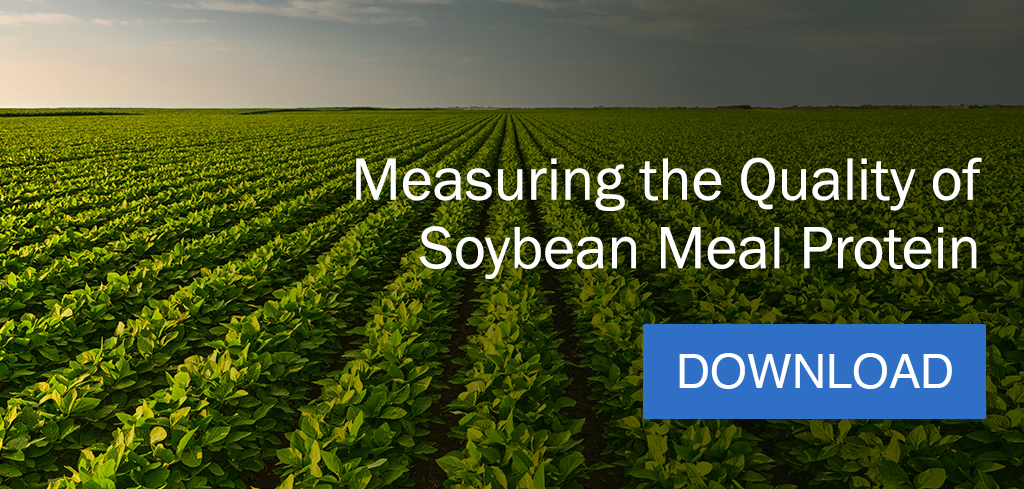
Soybean meal is the primary source of protein for the animal feed industry, comprising nearly two-thirds of the global feed market. However, differences in soybean varieties, growing conditions, and processing methods can all impact the quality and composition of proteins in the meal. Monitoring soybean meal protein quality is key to optimizing feed rations.
Unfortunately, the metrics used to measure soymeal protein quality vary as much as the beans themselves, which makes analysis challenging. Different processors use various metrics to define the quality of their soy meal products, and these tests aren’t always standardized from one lab to the next.
Understanding what these metrics mean—as well as which ones are most important—can give processors a more complete picture of protein quality.
Soybean meal protein quality metrics
Protein is essential for animal growth and performance, so understanding the quality of soybean meal protein in animal diets allows producers to adjust feed formulations for optimal results. Protein quality essentially refers to the concentration and bioavailability of amino acids that are available to animals in terms of digestibility. Among oilseed meals, soybean meal has the highest digestibility of lysine, an essential amino acid that monogastric (single-stomached) animals like poultry cannot produce alone.
Although nutritious, soybeans also contain several anti-nutritional factors (ANF) that can decrease amino acid digestibility. The most troublesome ANF is trypsin inhibitor (TI), a protein produced by most legumes. As its name implies, TI blocks the activity of a digestive enzyme called trypsin that helps monogastric animals break down proteins into amino acids. This impairs the animal’s ability to absorb essential nutrients—causing decreased weight gain, intestinal inflammation, poor feed conversion, and wet litter.
Heat treatment is the most effective solution to deactivate ANF, while improving the protein quality. Excessive heat, however, can damage the proteins, destroy certain nutrients, and decrease lysine digestibility—a process called the Maillard reaction. To gauge whether soybean meal has received enough heat treatment to deactivate the anti-nutritional factors, but not too much heat treatment to destroy the protein quality, processors rely on several different protein quality metrics.
Trypsin inhibitor activity
Since trypsin inhibitors interfere with protein digestibility, feed conversion, and weight gain, measuring TI activity is the most critical metric to monitor when assessing soybean meal protein quality. Insufficient heat treatment may lead to under-processed soybean meal. Measuring TI levels in samples in a laboratory can determine if the meal (mechanically or solvent-extracted) is under-processed. Feed mills and processing plants can work with certified commercial analytical labs for the feed industry to complete this testing.
Urease activity
Soybeans contain another natural enzyme called urease, which breaks down urea into ammonia and carbon dioxide. Urea activity is measured by the rise in pH from the release of ammonia. Under-processed soybean meal contains more urease, causing a higher pH rise.
Simultaneously feeding ruminants urea and raw soybeans or under-processed soybean meal can cause ammonia toxicity. Soybean meal must be heat treated to minimize this possibility.
There is a correlation between urease activity and trypsin inhibitors that only applies to solvent extraction processing. Therefore, this test is only effective for monitoring the quality of solvent-extracted soybean meal protein as an indirect correlation to trypsin inhibitor activity.
Protein solubility
Protein solubility tests detect over-processed soy meal by measuring protein solubility in a potassium hydroxide (KOH) solution. The solubility is inversely related to the degree of heat treatment, so lower numbers indicate overprocessing.
Solubility tests are typically used with solvent-extracted soybean meal, which undergoes heat treatment after the oil has been chemically extracted. This meal is more likely to be overheated, which can be measured by solubility.
Mechanically expelled soybean meal, on the other hand, undergoes heat treatment before the oil is removed. Full-fat soybeans are fed into a dry extrusion system like the Anderson Dox Extruder™ that quickly cooks, dries, and shears oilseeds with a short residence time of about 30 seconds—delivering just enough heat to destroy the trypsin inhibitors without damaging the proteins. This extruded material is optimized for more efficient pressing in a mechanical oil expeller, which generates additional frictional heat to promote optimal protein composition. Therefore, solubility testing of mechanically extracted soybean meal is not applicable.
Read more about expeller-pressed soybean meal
Protein Dispersibility Index (PDI)
Another less common metric is the protein dispersibility index (PDI), which measures the amount of protein dispersed in water after blending a sample at high speed. This metric can help detect the degree of underheating in both mechanically and solvent-extracted soybean meals. It is often paired with other metrics, like urease activity or protein solubility, for a more complete assessment.
The best test for soybean meal protein quality
These protein quality tests help processors gauge whether soybean meal has been under or overprocessed to optimize the digestibility of vital amino acids. But the only metric that directly measures the presence of harmful ANFs is trypsin inhibitor activity—making this the most effective test to run.
Regardless of which metrics are used to assess protein quality, processors need to understand how different processing systems and steps impact the nutritional value of soybean meal. The right soybean processing system can ensure the perfect temperature and ideal exposure to produce high-quality protein.
The Anderson Dox™ extruder strikes this balance perfectly by neutralizing anti-nutritional factors to improve protein availability. The Dox helps processors achieve the desired quality metrics to produce nutritious, digestible meal efficiently.
To learn more about measuring and maximizing soybean meal protein quality, download Anderson’s latest guide.

